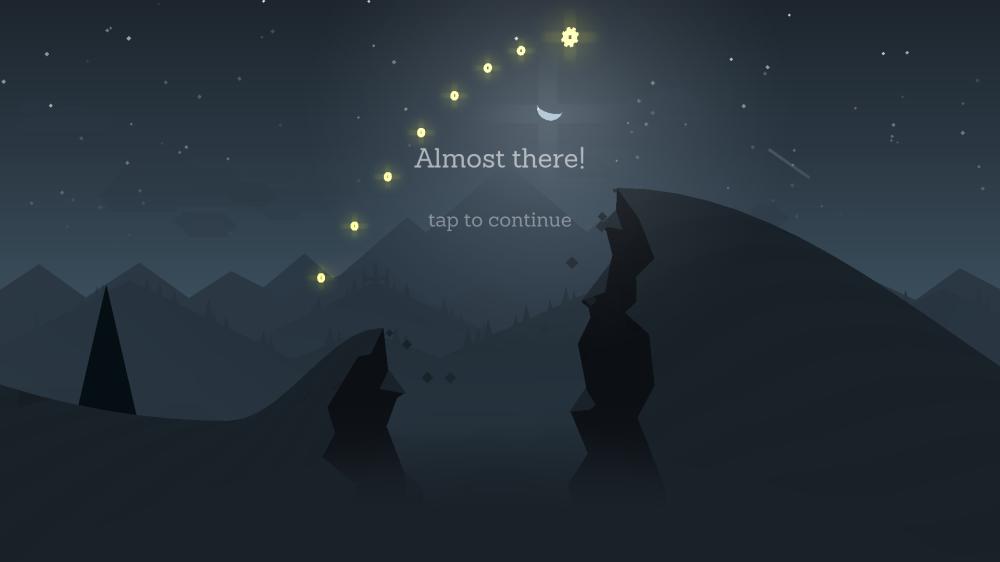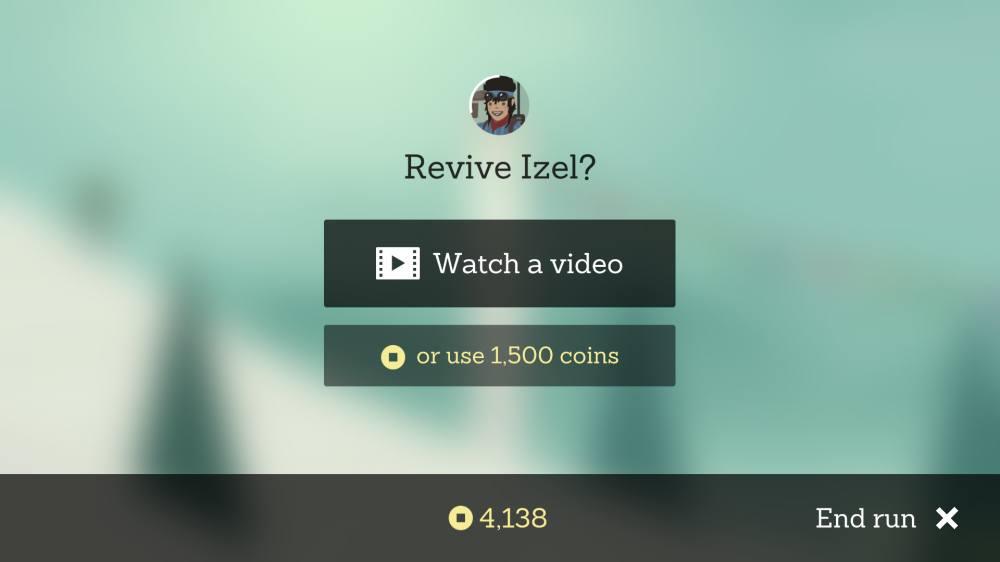Hi there! This blog is no longer maintained. All posts here have been migrated to my main blog, sarriest.wordpress.com.
Alto’s Adventure is a beautiful 2D endless runner in which you snowboard down the mountains to rescue your runaway llamas, all the while doing backflips and other tricks. Its minimalist art style is really beautiful and almost ethereal, reminiscent of games like Journey and Monument Valley.

Look at how beautiful the game is!
I’m been playing this game for a couple of months now, and there are so many good design elements in it. I won’t be focusing on that today though; instead, I’ll be breaking the game down into its formal elements. The concepts here are largely informed by the book Game Design Workshop by Tracy Fullerton, in case anybody is interested in finding out more about formal game elements.
1. Players
The player pattern for Alto’s Adventure is single player vs game system – the game structures are what creates the conflict for the player.
2. Objectives
Alto’s Adventure is interesting because it presents a number of different game objectives. Being an endless runner, its main objective type is that of a rescue/escape (get a defined unit to safety): try to get as far down the mountain as you can without dying. This is told to the player in the context of its backstory (“Your llamas are escaping down the mountain! Quick, grab your snowboard and chase after them!”). It’s secondary objectives come in the form of its many in-game goals, from chase (catch or elude and opponent – “Escape 2 elders in one run”), to alignment (arrange your game piece in a certain spatial configuration – “Proximity wingsuit for 50m in a row”).
3. Procedures
This refers to the actions/methods of play the player can take in the game to achieve its objectives. Alto’s Adventure has only 2 controls: tap to jump, and tap and hold to backflip. These guide player behavior, allowing for many different interactions with each in-game object, such as a rock bounce or bunting grind, based on when those actions are executed.
4. Rules
These define game objects, limit player behavior, and the consequences of player actions. Like most games, Alto’s Adventure has a ton of rules. Here are some of examples, split up into different categories:
Character speed (defining game objects)
- Doing a single trick gives you a speed boost
- Chaining multiple tricks gives you a larger speed boost
- Sliding on a patch of ice gives you a speed boost
- The speed boost lasts or a fixed amount of time which is character dependent
- Jumping removes the speed boost
Using the wingsuit (limiting player behavior)
- The wingsuit is only available after the character’s scarf has reached its maximum length from doing tricks
- You cannot fly out the top of the screen
- The wingsuit lasts for a fixed duration
- Flying too close to the ground will end the wingsuit effect
Triggering the lose state (consequences of player actions)
- Landing on your head while doing a backflip
- Tripping over a rock or campfire
- Falling into a chasm
- Getting whacked by an elder

Getting chased by an elder.
5. Resources
These are valuable game objects which the player needs in order to achieve an objective. Value is determined by utility (how useful it is to the player at that point in time) and scarcity (how available/prevalent it is). Alto’s Adventure makes use of a number of common resources, such as:
- Lives: You only have 1 life!
- Power-ups: Coin magnet, hover feather, wingsuit, llama horn
- Time: Power-ups last for a limited amount of time
- Currency: You need to collect coins in order to buy in-game items
- Special terrain: Certain in-game goals can only be completed in specific areas (“Land 2 backflips in a single forest”)
6. Conflict
Conflicts are anything which prevent the player from achieving his goal. There are 3 main types:
- Obstacles (physical/mental). The most obvious physical obstacles are the rocks, campfires, and chasms, all of which can kill the player. Other less explicit obstacles come in the form of things like trees, which can block the player’s view of their character, and the weather, which can reduce visibility drastically.
- Opponents. This particular conflict complements the other 2 really well in Alto’s Adventure. AI elders chase after the player, and take him out if they catch up. The only way to escape is to gain enough speed from doing tricks (creating player dilemmas), and jumping over over a chasm (physical obstacles).
- Dilemmas. The player has the choice of whether he wants to get more points by doing tricks and risking death, or playing it safe and keeping tricks to a minimum. An especially interesting dilemma is having to time certain tricks just right – do you have enough airtime to squeeze in another backflip, or would that lead you to a snowy crash?
7. Boundaries
The boundaries here refer to what separates the play area from everything else. Aside from the obvious mobile device, the zoom level of the camera is a boundary: when the game first starts, it is relatively zoomed in, but as the character picks up speed, it zooms out to let the player see what is ahead. An interesting thing about Alto’s Adventure is that the zoom amount is fixed for chasms – it is always zoomed out. There is also a conceptual boundary – the player gets to be a daredevil character in the game, doing all sorts of crazy tricks which one would never do in real life.
8. Outcome
Alto’s Adventure doesn’t exactly have a proper win condition, since it is an endless runner and you just want to get as far as possible. However, the addition of in-game goals does give a bit of that feel, as you can complete all its 180 goals. Completing an individual goal, or even all the goals for a particular level, must be differentiated from “winning” the game though, since the main goal of the game is to survive as long as possible. The uncertainty in this outcome comes from the procedurally generated terrain, which one cannot predict and hence can end up losing at any time.

The hardest chasm to jump across.
Bonus: On monetization
I really like how Alto’s Adventure (for Android, because that’s what I use) does it. It’s a freemium game, but I believe its main revenue source comes in the form of ads. I know what you’re thinking: ads suck, they are unsightly and don’t belong in such a pretty game, etc. etc. But here’s where Alto’s Adventure differs from a lot of similar games – these ads aren’t forced on you. You, as the player, willingly choose to watch them. What do I mean? Lets’s take a look at 2 places where the ads are found in-game.
Immediately after your character dies

Option to revive your character.
Occasionally, you are given the choice to revive your character by either paying 1,500 coins, or watching an ad. This works really well for a few reasons:
- Humans hate having things taken away from them. In this case, it’s about losing the progress you’ve made down the mountain. After spending a good 10 minutes on a run, if you made a stupid mistake and died, but were then given a second chance… most people would take it.
- It behaves as a scarce resource. This option isn’t given every time you die, so when it does appear, people naturally want to grab it. There is also a timer (around the character’s avatar) during which they need to make the decision of whether they want to revive the character and how, which adds a sense of urgency.
- It provides a relatively useless/much lousier choice. Elsewhere, watching an ad gives you 500 coins. Here, if you watch an ad, you get something of 1,500 coins in value, and those 1,500 coins you saved, which happen to take quite a few runs to earn, can be better spent on power-ups. Of course you’ll choose to watch the ad!
- Design of the watch ad button. Notice how they used the term “video” instead of “ad”. Also notice the emphasis on that button: it’s much bigger, highlighted, and closer than the other button to the text “Revive <character name>?”.
In the workshop
The workshop is where you can buy power-ups and upgrade them. When you don’t have enough coins to purchase something, the game tells you that you don’t have enough money, and gives you an option to earn 500 coins immediately by watching an ad.

Would you like 500 coins for free so you can buy your item?
You’ve just seen something you want but it’s just out of your reach, and then you’re presented with an easy way to get that thing. The way the power-ups work is also brilliant, because you’re not paying for an item per se, which can sometimes make players feel bad/ashamed that they need help (a power-up) in order to achieve a goal, or lessen the sense of accomplishment when they player achieves the goal. Instead, you’re paying for the opportunity to collect the power-up in game. You feel great about yourself, because you still require skill in order to get the power-up.
The in-game goals also tie in with these items very well – you can enjoy the game without buying any of these power-ups, but you’ll soon find yourself stuck on a goal, and that means being unable to unlock new characters. The game is smart in that the first such goal is presented after the player has unlocked 2 other characters. They have gotten a taste of the special abilities of each character and want more.
My favorite part about all of this? You’re not actually missing out on anything if you don’t watch the ads!
Excellent analysis of the game. It was really interesting to hear about different parts of the design of a game I’ve never heard about. The parts that stuck out to me were 1) boundaries, and 2) monetization. Regarding the first, I liked how the game zooms as the player speeds up: it’s a subtle design but really helps with gameplay. About the second: I appreciate the design of the ads as non-intrusive as possible! A lot of games are pretty bad about this, showing little unaesthetic popups. Not only does Alto’s Adventure display it in a visually appealing manner, it uses psychology to get players to do so– of their own “choice”!
LikeLike
I personally am not a fan of freemium mobile games or endless runners, so it’s difficult to relate to your article. I do like that it appears that Alto’s Adventure has taken a different perspective on the endless runner, literally, and through the form of its different art style. The actual game play seems to derive itself from the established model set by Temple Run, but the concept of having to build up speed to cross massive chasms is a refreshing variation from the model. I do appreciate that the game did not take its freemium model in the time blocked direction that games like clash of clans and candy crush use, as these break the players immersion in the game significantly. At least under this model your immersion is only broken for a short period of time. I doubt that I will play Alto’s Adventure, but thank you for sharing a unique type of endless runner.
LikeLike
I certainly can relate to the frustration of intrusive advertisements in freemium mobile games. Videos are especially frustrating since they force players to wait for a period of time. It breaks the experience that any player may have. I think that Alto’s Adventure has indeed done a great job at making advertising unobtrusive. They provide sufficient motivation in the game to click the advertisement but yet offer players a choice to view it. I think that this is an important design flaw in many freemium mobiles games where videos or advertisements appear mid-way through a gameplay session. There are many lessons to be learnt from Alto’s Adventure that you have mentioned, I hope that more games in the future follows a similar style.
LikeLike